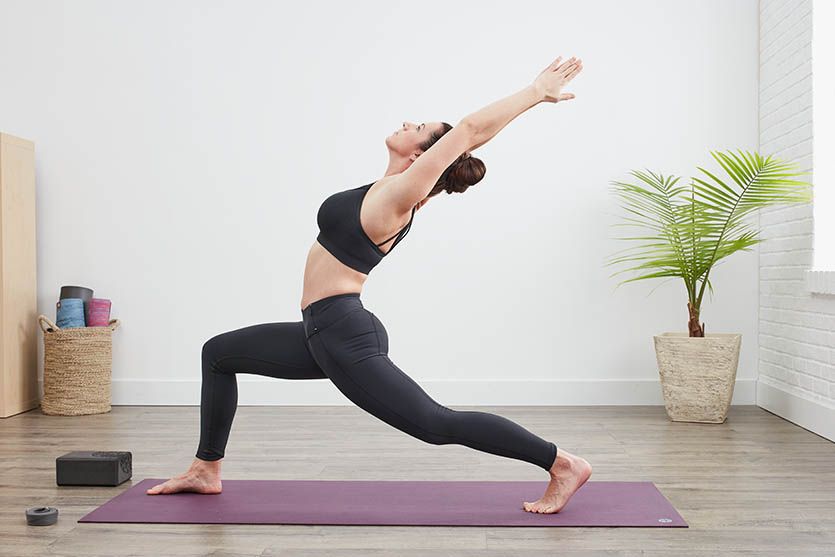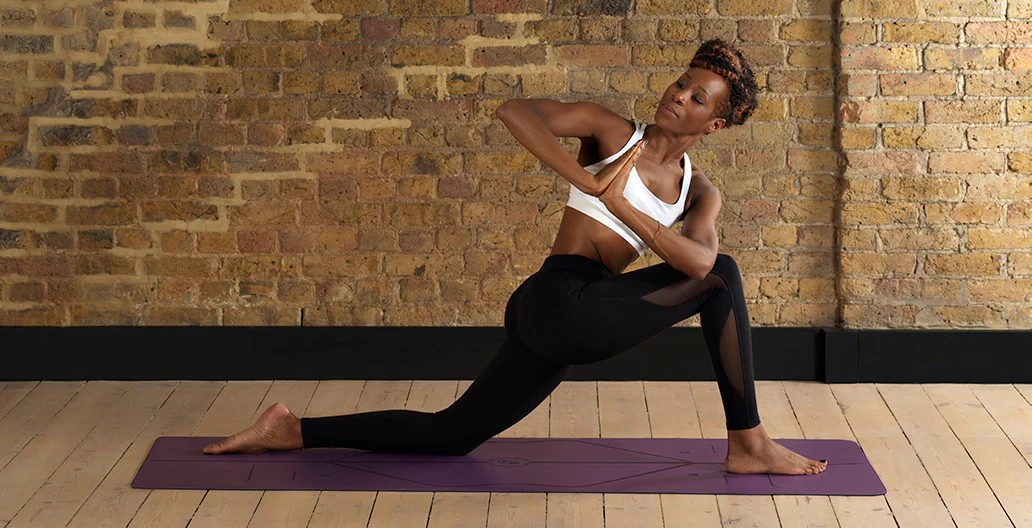What is Anjaneyasana (Crescent Moon Pose)?

Anjaneyasana, or Crescent Moon Pose, is a standing low lunge position that opens the legs, pelvis, chest, and spine. It's used as a post-workout pose to relax the entire body or to improve your body posture.
To get into this pose, one leg is stretched behind you on the mat, with your knee resting on the ground. Your other leg is placed between your hands, making an angle of 90 degrees with a bent knee. By extending your arms overhead, your spine is flexed to open your chest muscle, and creating a shape like a crescent moon.
The Crescent moon pose is also used as a variation of the Equestrian pose in the Surya Namskara flow. This posture helps improve overall body balance, stability, and focus.
Overview & Etymology
The Sanskrit word Anjaneyasana means, 'Anjaneya' Mother of Lord Hanuman, and 'Asana' means posture.
This yoga posture has not been featured in any Hatha yoga texts. This pose was inspired by Indian Martial Arts and was recently introduced in the 20th century as a Surya Namaskar variation in the modern Sivananda yoga schools.
In Anjana's past life, she was cursed by a sage to be born as a monkey.
As she begged for pardon, the sage told her to perform Tapasya (austerities or penances), and as a result, she would give birth to a powerful avatar, by which she could return to her original form of a nymph.
Hanuman was the son of an Anjana and the king of the Vanar tribe Kesari.
As per Hindu mythology - The Ramayana, Lord Hanuman was a member of the Vanar (half man-half monkey) tribe and reincarnation of Lord Shiva. He was a superhero because of his majestic powers and he played a crucial role in the Ramayana.
Anjana used to perform Tapasya as a yogini in the jungles. She mastered all her senses with yoga, and the strength of her practice is honored by this Crescent Moon pose bearing her name.
Sanskrit Name: अञ्जनेयासन Pronunciation: AHN-jah-nay-AHS-uh-nuh
Pose Type: Standing Hip Opener Also known as: Crescent Moon Pose, Low Lunge Pose
Strengthens: Thigh, Back, Knee, and Quadriceps
Stretches: Thighs, Abdomen, Chest, Hamstrings, Lower Back, Spine, and Groin
Health Benefits of Anjaneyasana
Improves posture.
Reduces stress and tension.
Balances emotions and increases focus.
Relaxes and re-energizes the whole body.
Strengthens the back, quads, and knee joints.
Stretches the chest, back, groin, and inner thighs.
Opens the Heart Chakra and stimulates the Anahata energy.
Alleviates pain from the back and tightness in the lower body.
Enhances flexibility, mobility, and range of motion in the body.
Has therapeutic healing effects on back pain, digestion, and reproduction aliments.
When to Avoid Performing Anjaneyasana
Avoid if you have had a recent injury or surgery.
Avoid during pregnancy and post-pregnancy.
Avoid if you feel vertigo or migraine symptoms.
Avoid if you have weak knees or inflammatory knee arthritis.
How to do Anjaneyasana (Crescent Moon Pose)
The Crescent pose is a powerful kneeling, spinal stretching pose. It's not very beginner-friendly, so it's important to follow the steps in chronological order to get the most benefits from this pose.
Part 1 - Preparatory Poses for Anjaneyasana
To execute the Crescent moon pose properly, you'll need to start with some easy warm-up poses that prepare your back, abdomen, inner thighs, hip flexors, and knees for the main stretching pose and keep your muscles safe post-workout.
1. Utthita Trikonasana (Extended Triangle Pose) - Stand in a five-point star standing position and exhale as you bend your torso at one side, over your right leg. Rest your right palm over your right shin or on the mat.

The Triangle pose activates the obliques, lower back, and inner thighs. It will also stretch hamstrings, glutes, and hip flexors. This pose will help you increase balance and blood circulation in your entire body. Hold this extended side stretch for a few seconds, and then repeat the same on the other side.
2. Utthita Ashwa Sanchalanasana (Runners Lunge Pose) - To get into the pose, start in a low lunge close to the mat with your right foot forward and your left foot behind you. Place both hands on the ground on either side of your right foot, and then slowly straighten your left leg. Keep your pelvis squared and your front knee directly over your ankle.

Make sure your knee is not over-extending past your foot. Maintain this pose here for a few deep breaths, and repeat the same on the other side. This yoga pose is a perfect way to activate your lower back, open up your hip flexors, and stretch out your thighs and groin.
Part 2: Step-by-Step Instructions to Perform Anjaneyasana
The following are steps to perform Anjaneyasana or Crescent Moon Pose:
Step 1- Start in the Runner's Lunge pose or Lizard pose and get lower on the mat by resting your right leg behind you on the ground.
Step 2- Keep your hips square as you bend your left knee to 90 degrees.
Step 3- Place your palms at your waist, and make sure your right knee is resting on the ground with toes pointed, and your heel facing up toward the ceiling.
Step 4- As you inhale, raise both arms overhead slowly, lengthening your spine and looking up toward the sky.
Step 5- Keep breathing and opening your chest and slightly drop your neck back to feel a minimal stretch in your neck as well.
Step 6- This step is optional: If your back feels comfortable enough, keep breathing and arching your spine until your spine forms a crescent moon shape.
Step 7- Hold this pose here for 5-10 breaths. Slowly come back up and relax for a few seconds. Finally, repeat on the other side.
Breathe Awareness -
Inhalation: Inhale as you raise your arms overhead and flex your spine in crescent moon shape.
Exhalation: When your spine comes back to a neutral position during relaxation.
Inhale & Exhale: As you maintain this pose for a longer duration or while flexing the spine deeper.
Performance Duration for Beginners: Hold Anjaneyasana for 4-8 deep breaths on each side.
Performance Duration for Advanced: Hold Anjaneyasana for 1-3 minutes on each side.
Part 3: Things to Keep in Mind
The following are some alignment cues that are essential for the safe execution of the Crescent Moon pose:
Do not overextend your knee: When your front leg is bent, make sure your knee does not go beyond your ankle. This will ensure that your knee is not over-extended and remains safe. If you overextend, you can cause wear and tear in the quads, which can cause pain or even lead to a severe knee injury.
Keep your core engaged: Activate your core muscles by drawing your navel in toward your spine. This will help you retain your body balance and alignment while one knee is flexed behind you and one foot is placed in front.
Keep your shoulders relaxed: Let your arms hang heavy by your sides and relax your shoulders. This will help you avoid tension, pain, or injury in your neck and shoulders.
Gaze upwards: Keep your gaze fixed on a point in front of and slightly above you, like where a wall and a ceiling meet. This will help you stabilize your body and prevent unnecessary straining of the neck.
Part 4: Relaxing Poses After Anjaneyasana
After practicing this challenging spine bending pose, it is important to take some time to relax your back muscles and allow your body to recover.
Here are some poses that can help you relax after your Crescent Moon practice:
1. Uttanasana (Standing Forward Bend Pose) - This is a great counter pose to help relax your hamstrings, shoulders, and low back. To perform Uttanasana, stand with your feet less than hip-width apart.

Inhale, lift your arms overhead and lengthen your spine. As you exhale, fold forward from your torso and rest your forehead against your knees, keeping your back flat. Let your arms hang loosely in front. Stay in this pose for at least 10 to 50 seconds.
2. Ardha Kapotasana (Half Pigeon Pose/Resting Pigeon Pose) - This pose is helpful in relaxing your low back, pelvis, and hamstrings on a deeper level, by changing your front leg position on the mat from the low lunge position.

Place your front leg horizontally between your hands and rest your pelvis completely on the ground. You can either sit here or bend your upper body forward on the ground to relax your spine and legs even further. Hold this pose on each side for one minute.
Anjaneyasana Variations to Consider
Every practitioner has their own journey, and at each phase of your journey, you will either be required to ease your posture or challenge yourself for better growth.
Here are a few variations for all levels of practitioners to try:
1. Anjaneyasana Hands to Knee Variation - Get into a standing lunge pose and gently rest your straight leg on the ground. Place both hands on your knees and try to gaze at the point where the wall and ceiling meet – this will help you lengthen your spine.

This pose variation is great for beginners who want to bring some balance to their Crescent Moon pose. Hold this on each side for a few minutes, then relax your neck and spine.
2. Anjaneyasana Quad Stretch Variation - If you feel balanced enough in the Crescent Moon pose and can hold the primary position for a long duration, then it's time to challenge yourself.

Gently lift the foot of your back leg, stretch it towards your same glute, and hold it with your hands. Hold this variation for one minute on each side as you feel a deeper flexion in the front thighs, quads, and knees.
3. Parvrtta Anjaneyasana (Revolved Low Lunge Pose) - For this variation, continue the Crescent Moon pose and bring your arms in Anjali Mudra (Prayer Formation).

Now, twist your upper body to the right side and bring your gaze to the right side. Hold this pose for one minute, and then repeat the same on the left side. This pose helps you strengthen your obliques and increase your range of motion in the lower back.

Enjoy a Free 1-on-1 Session with a Coach!
Receive personalized guidance tailored to your unique fitness goals, live with a dedicated coach—no credit card required.
Frequently Asked Questions about Anjaneyasana
Anjaneyasana comes from a combination of two words, 'Anjani,' which means "Lord Hanuman's Mother," and 'Asana,' which means pose or posture. Anjaneyasana symbolizes mastery over all the senses, just like Anjani did with her yoga practice to set herself free from the curse.
Anjaneyasana or Crescent Moon Pose is also known as a low lunge yoga pose with a backward stretch. A similar variation of the Crescent Moon Pose is also included in various yoga flows like Sun Salutations.
Anjaneyasana helps stretch all the major muscles, like your legs, glutes, inner thighs, hip-flexors, low back, spine, and neck. This pose also releases tension from your spine and relieves mild symptoms of low back pain.
Low lunge hands to the knee pose, low lunge quad stretch, and revolved low lunge pose are some commonly used Anjaneyasana variations.
Practitioners with any recent injury, surgery, inflammatory knee arthritis, vertigo, or even migraine symptoms should not perform Anjaneyasana. Also, women should avoid this pose during their menstruation cycle, and during pregnancy or post-pregnancy.
Standing forward bend pose, half pigeon pose, or resting pigeon pose are some of the best counter-yoga poses to practice after Anjaneyasana. These poses will help you move your spine in the opposite direction and bring the curve of your spine back into its neutral position.



.webp)
%20(7).jpg)




